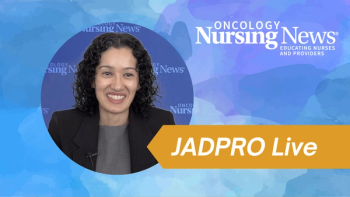
- June 2018
- Volume 12
- Issue 5
Fighting Health Illiteracy to Prevent Gaps in Care
Sam didn’t understand the scope or severity of his illness until his nurse navigator intervened.
Megan Roy, BSN, RN, RN-BC, OCN
Last summer, I received a frantic call from a patient’s son. His father had been diagnosed with stage IV non—small cell lung cancer in the spring and had never told anyone. The son found out about the diagnosis because his father was currently in our emergency department (ED) for a cardiac complication, and the ED doctor inquired about his lung cancer treatment.
As their nurse navigator, I sat down with the father and son to discuss what the next steps should be after discharge from the hospital. Unfortunately, the patient, whom I will call Sam, had insurance that was nonparticipating with my institution. I called his insurance company and found out where Sam could receive his oncology care and still be covered. I made his first appointment and requested records to be sent to the new provider. I answered all his son’s questions and offered emotional support. I did not expect to hear from Sam or his son again.
At the end of that summer, Sam’s name came across my desk again. He had requested an appointment with our institution’s pulmonology group. When I called and spoke with Sam, he was adamant about receiving care at my institution. Since his insurance was state Medicaid, I knew he would be able to switch to a different company that our institution accepted. I connected him to one of our financial advocates, who helped him change insurance companies. When I next spoke with Sam, I told him that although he did not need a pulmonologist, he needed a medical oncologist, and I scheduled an appointment for him with one that specializes in lung cancer. Unfortunately, he was very ill at this appointment, and our oncologist directly admitted him to our hospital.
After that hospital stay, Sam did not keep his next appointment with the medical oncologist or return any of my calls. I reached out to his son and received no response. I did not hear from Sam until 3 months later, when he called and scheduled another appointment with the medical oncologist. I found out that he had not received any treatment for his cancer that he was diagnosed with 7 months earlier, and I was naturally extremely concerned for him.
I met with Sam, and we had a very frank discussion. I realized that he had huge knowledge gaps about his disease and prognosis. I think Sam didn’t realize how sick he was because he felt alright. Many patients with lung cancer don’t have symptoms until the late stages of the disease. Sam also had transportation barriers, and he was reluctant to treat his cancer. To ensure Sam’s attendance and comprehension of the situation, I accompanied him to his appointment with the medical oncologist. We made sure he understood what the treatment regimen would be. We also discussed his prognosis with and without treatment. At the meeting, he told me he hadn’t realized how serious his diagnosis was. He said he did not want to give up hope and chose to get the prescribed treatment.
During this meeting, I found out about a social worker in his community who could assist him with keeping his medical treatments. Together, we were able to coordinate his treatments, arrange his rides, and remind him the night before about his appointments. We offered him the support he needed to get through treatment.
Sam’s delay in care was directly attributable to his lack of health literacy. According to the US Department of Health and Human Services, “health literacy is the degree to which individuals have the capacity to obtain, process, and understand basic health information and services needed to make appropriate health decisions.”1 Health literacy is a barrier that is hard to measure because patients are good at pretending they understand everything they are told. In my experience, patients who are labeled “noncompliant” tend to have a health literacy deficit.
Nurse navigators must assess how much patients understand and make sure that they have all the information and support needed to make an informed decision about their care. Now, I make a point of asking my patients questions about what the doctor told them so I can assess what educational needs they have in relation to their health and treatment regimens.
Some patients choose not to pursue treatment, which is acceptable as long as they are making an informed decision. In my discussions with patients regarding their diagnosis, treatments, and multiple prognoses relative to their chosen course of treatments, I make sure that they can verbalize the consequences of not receiving the recommended care and have access to supportive care once needed. Comprehension of possible outcomes of chosen treatments (or nontreatments, as the case may be) is an essential aspect of patient compliance.
Megan Roy is an oncology nurse navigator at the Abramson Cancer Center, Penn Medicine in Philadelphia, Pennsylvania.
REFERENCE
1. US Department of Health and Human Services. National action plan to improve health literacy. health.gov/communication/HLActionPlan/pdf/Health_Literacy_Action_Plan.pdf. Published 2010. Accessed April 26, 2018.
Articles in this issue
over 7 years ago
Transform Your Presentation Into a Publicationover 7 years ago
Nurse Prideover 7 years ago
Financial Toxicity and Patient Careover 7 years ago
Managing Cancer Pain in an Era of Opioid Abuseover 7 years ago
Nurse Trust Among Patients With Portsover 7 years ago
Finding a New Beat: Drumming as Therapy for Breast Cancerover 7 years ago
Creating New Roles in NursingNewsletter
Knowledge is power. Don’t miss the most recent breakthroughs in cancer care.
















































































